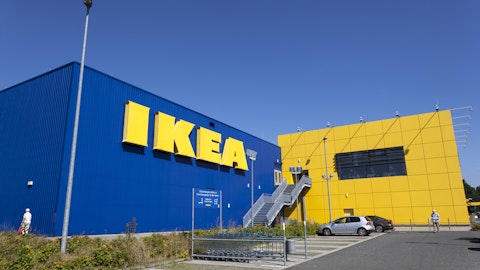Kate McShane: I wondered if you could talk to any category performance during the quarter, just maybe how apparel and footwear looked relative to the second quarter year-over-year. And are you seeing any stabilization in some of the bigger ticket categories that maybe were COVID beneficiary categories a couple of years ago?
Lauren Hobart: Thanks, Kate. Yes. The story in Q3 from a category level really was about the strength of our back-to-school business. We saw strength as back-to-school has different cycles throughout the country, early, mid and late back school, and we could literally see the comps follow those trends. The back-to-school categories were performing so well. So collectively, that is footwear and apparel and hydration, which is doing incredibly well and then other accessories like backpacks, socks and those sorts of things. So, we’re very pleased with overall, how our key categories performed in Q3. Looking at the higher ticket, the COVID categories, I wanted to just remind you, they are a smaller percentage of our business. And across the board, they remain significantly higher than our pre-COVID levels. We do expect long-term growth in those categories. We’re just managing through them. But they are a small percentage of our business relative to the rest.
Kate McShane: And if I could just have a follow-up question with regards to your commentary around House of Sport [Technical Difficulty] brands. Can you talk at all as to what those are and maybe how the brand distribution or just what brands are carrying?
Lauren Hobart: Yes, sure. I think House of Sport is unique and that it is totally rooted in sport, and it’s a fantastic destination for all of our brands. So if you look at some of our bigger brand partners, it’s one of the best presentations — they’ve said, one of the best presentations of their brands that they see. It’s also an opportunity because of the size and the level of service where we can bring in new and emerging brands. And through that channel, we brought in brands like FP Movement and On and HOKA. And so — and those then have ability to transfer down to the rest of the chain as we become partners. So, our vertical brands also have incredible presence in our House of Sport stores. We leave with them across the board in many of our entrances And they’re doing quite well, too. So overall, just — it’s a fantastic presentation and really puts brands in their best light.
Operator: We’ll go next now to Mike Baker at D.A. Davidson.
Mike Baker: So a couple of margin questions. One, you talked about SG&A growing less next year. Have you — can you talk about what your breakeven comp is in terms of SG&A? What kind of comp do you need next year to leverage your SG&A? And maybe along the same lines, what kind of comp you need for total EBT margins to be up, in other words, incorporating what might go on a gross margin in that as well?
Navdeep Gupta: Yes, Mike, thanks for the question. Maybe I’ll start with the Q3 performance that we saw in the SG&A. So the SG&A came in from a rate perspective. It’s still deleveraged 100 basis points but it was lower than the expectation that we had given at the end of Q2, driven by three primary things. First, the top line came in at the higher end of our expectations. So we’re very pleased with the productivity that we were able to drive from just the leverage on the higher level of top line performance. Second, really, really focused about the work that got done within the collective organization to be able to drive productivity and efficiency pretty much in the discretionary areas away from the core strategies of the Company.
So, you saw the results of that manifest through the P&L that we delivered. And then, some of the actions that we undertook here in the business optimization, the early parts of those benefits were also in Q3. And we expect a similar outlook as we shared for Q4. We expect SG&A to deleverage in the similar zone as where the deleverage in Q3 came in. In terms of 2024, here’s the way I’ll say it, because we are not ready to provide guidance as yet for 2024, but here’s a framework to think about it. The business optimization actions that we have taken, particularly in the Moosejaw and Public Lands businesses being brought together, that benefit will continue into 2024. And that’s the reason we said our SG&A will significantly moderate in terms of the growth as we go into ‘24.
In addition, the work that we are doing currently and have done in the discretionary cost area in Q3 and in Q4, we expect that benefit also to continue into 2024. So, we’ll share more at the next earnings call about our ‘24 expectations, including the top line and the SG&A and the profitability expectation.
Mike Baker: Okay. Fair enough. One other, I guess, follow-up but candidly, a different topic. Historically, in a lot of ways, back-to-school is a very good leading indicator for holiday sales. You had a very good back-to-school. Historically, in your business, have you seen that kind of correlation between holiday sales and back-to-school?
Navdeep Gupta: I would say what we are really pleased is the fact that our consumer is holding up really well. We are seeing growth both in our transaction and in our ticket. And as Lauren indicated, we have not seen any trade downs. And all income demographics across our portfolio actually grew. However, the competitive set in holidays is different than back-to-school season. So, we are very optimistic about the things that are within our control, our assortment, our service levels as well as the experience in the stores are ready to serve our athletes. And we couldn’t be more excited about the holiday season.
Mike Baker: Great. Fair enough. Look forward to seeing the new store in the Prudential Center up here in Boston.
Lauren Hobart: Us, too.
Navdeep Gupta: Us, too.
Operator: We’ll go next now to Warren Cheng at Evercore ISI.
Warren Cheng: Just to follow up on your answer to Simeon’s question on the 4Q comp. So, the guidance implies a deceleration from the 1.7 from 3Q. So if we use that 3Q 1.7 levels as an anchor, the compares get easier going in the fourth quarter on both a year-over-year and multiyear basis. It sounds like the inventories are well stocked. 3Q had some unseasonal weather. So, as we think about that 3Q to 4Q sequential slowdown, are there factors that we should consider, or is that entirely just the macro caution that you talked about?





